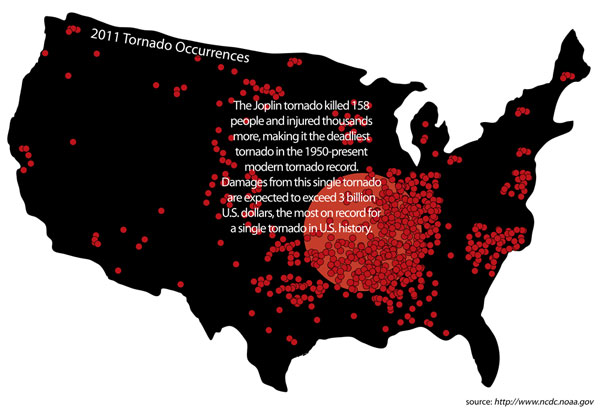
When my parents would tell me we were going on a trip over spring break or summer, I would think of somewhere tropical and hope to experience something we never had before. But no, we would pile in the car and drive a couple hours to Branson, going to Silver Dollar City, watching magic shows and staying at “The Splash Country Inn with an indoor water park!” but tiny rooms.
Now, however, two places that defined my childhood have been knocked off their feet, requiring rebuilding.
As the Branson tornado swept through the middle of the city on Leap Day a little over a week ago, it stirred the memories of the Joplin tornado. Some of you may be asking, “What the heck is going on here? Why are all these Missouri towns getting shredded to smithereens? Are we next on the list to be demolished?”
But these two tornado tragedies only two hours driving distance apart are common around this time of year; it’s just a rarity that both of these tornadoes happened to touch down in urbanized cities. Tornadoes from F1 ratings,categorized as weak, to F3 ratings, categorized as severe, touch down a lot in this area, but the only damage ever seen is missing cattle and the random barn taken out in the middle of the farmed plains. It is puzzling that in a year’s time, two fairly powerful tornadoes touched down in the heart of bustling, highly populated cities.
This isn’t the end of the tragedies either. Since 1991, Missouri has averaged 45 tornadoes a year and 2.2 EF3 (severe) to EF5 (incredible) tornadoes a year and has been ranked 13th in frequency of tornadoes in the entire United States.
The difference between the Branson and Joplin tornado is substantial, though. I’m not saying the minor bruises Branson experienced were anything close to the gaping wounds Joplin residents had to stitch up. Joplin’s path of destruction was miles wide, taking everything in its path, while the Branson twister embodied the typical behavior of a tornado, jumping from place to place, blowing out windows in one building and leaving another untouched. I’ve seen instances where this has occurred when structures were only 10 yards apart.
Looking at pictures of the recent devastation in Branson, it may look kind of scary. But in reality, things that can bend or break easily will bend and break easily in fairly high winds. Things like street signs, trees, glass and awnings were disturbed since street signs blow over and sheet metal flies like paper in the rotating winds.
Welcome to tornado alley folks. Down in these parts, a tornado is regarded as a nuisance to most people. Sometimes I used to even look forward to them, living in Neosho. They are just so common to these residents that no one took them seriously, until now.
These reported tornadoes have almost been a blessing to every person who watched the reports all over the country. Sometimes, Americans need a little scare to catch their attention. But, Joplin had to learn things the hard way; they were the hypothetical “guinea pigs.”
There were 161 deaths in the Joplin tornado and none in the Branson tragedy because people were prepared. When the storm sirens sound, people don’t blow them off like they used to anymore, so I guess you could say people who experienced the tornado on May 22 suffered through it so that others don’t have to.
As for my beloved vacation spot, as a predominantly tourist and show-based town, only a few of the entertainment theatres were affected and a small amount of hotels damaged, but the town is still encouraging regular tourists. Even though this event may have scared a few people, this tourist town of 10,000 should be back on its feet in no time.
Who knows, maybe my spring break will include a trip down the road to see the recovery, embrace what is there and make more memories for the future.
By Kaitlyn Marsh

















































































